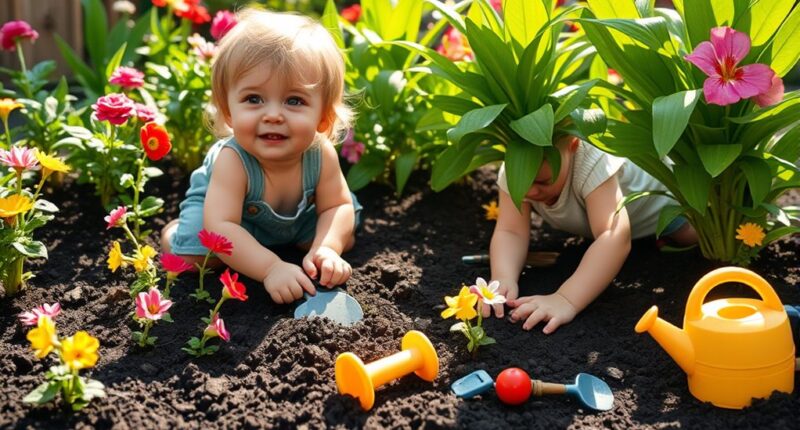Introducing your toddler to gardening is a wonderful way to connect them with nature. By engaging them in fun activities like planting seeds and caring for plants, they develop essential skills and an appreciation for the environment. Simple tasks, vibrant and safe plants, and a child-friendly garden design make it easy for your little one to explore. Plus, you’ll want to guarantee their safety while they enjoy this experience. Discover more ways to nurture their love for gardening!
Key Takeaways
- Engage toddlers with simple gardening tasks like planting seeds to encourage their connection with nature and promote sensory exploration.
- Create a safe and inviting garden space with soft flooring, smooth pathways, and shaded areas for comfortable play and exploration.
- Choose vibrant, soft-textured, and edible plants to stimulate toddlers’ curiosity and foster a hands-on understanding of growth and life cycles.
- Incorporate creative projects, like decorating pots and making funny face plants, to enhance children’s engagement and enjoyment in gardening activities.
- Ensure constant supervision and provide child-sized tools to promote safety while teaching toddlers proper gardening skills and responsibilities.
The Educational Benefits of Gardening for Toddlers
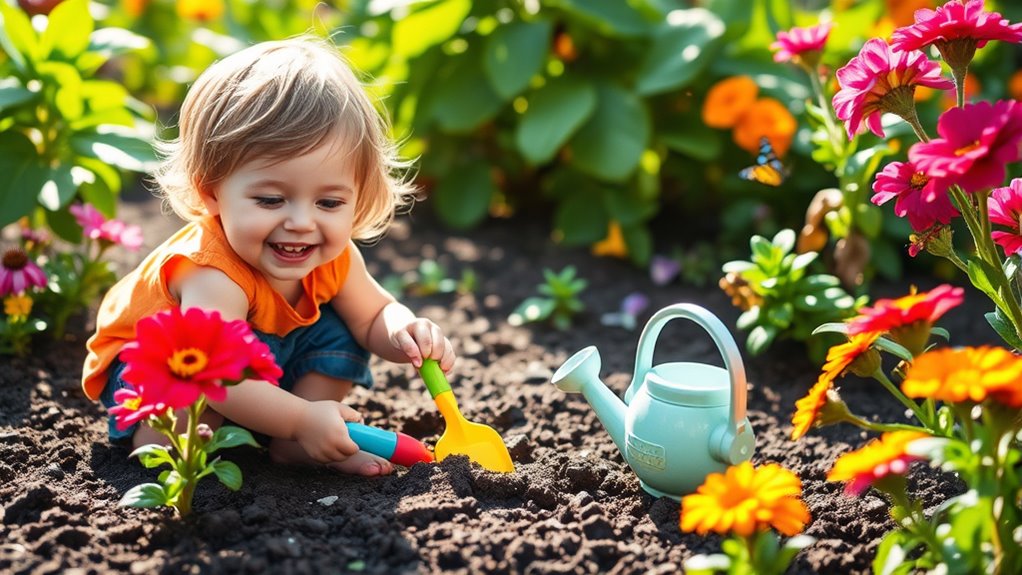
While many parents may not realize it, gardening can be a powerful tool for your toddler’s education. It introduces your child to science concepts like botany and ecology, fostering a deeper understanding of the natural world. Engaging with plants can also help children learn about environmental awareness, which is crucial for their development. Additionally, understanding how to practice sustainable living through gardening can instill a sense of responsibility towards the environment. The act of planting and nurturing a garden can also encourage mindful consumption, as children learn the importance of valuing resources and reducing waste.
The sensory-rich environment of a garden engages their sight, touch, smell, and taste, enhancing sensory learning. You’ll also find that gardening teaches basic math skills through counting seeds and measuring garden space. Furthermore, gardening can be a great way for children to explore diverse ecosystems, as they observe different plants and insects in their own backyard.
As your child waters and digs, they improve their fine motor skills and physical health. Plus, they learn responsibility by caring for plants, developing confidence and independence along the way. Additionally, gardening can help families cut expenses in half by providing fresh produce right from the backyard.
Engaging and Easy Gardening Activities
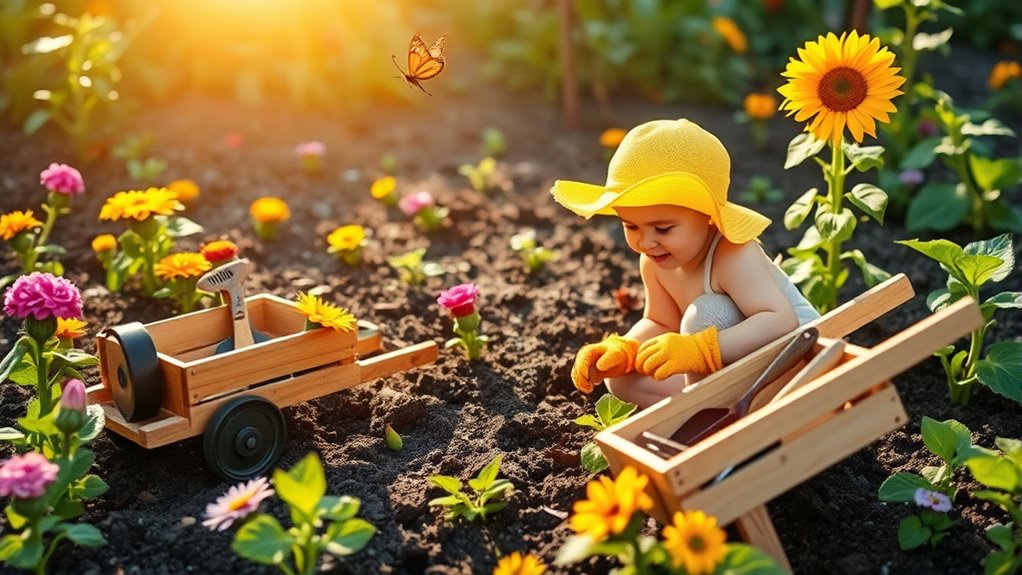
Gardening offers an exciting way for toddlers to engage with the world around them, building on the educational benefits discussed earlier.
Start with simple activities like seed planting or growing cress heads. These tasks are manageable and quick, keeping your little ones interested. Create funny face plants using cat grass for a fun twist, or pot colorful containers to brighten up your space. Additionally, consider incorporating nutritional balance by planting a variety of fruits and vegetables to teach kids about healthy eating. For instance, planting oranges needed for a gallon can help them understand the effort involved in producing their favorite juices. You can also introduce them to the concept of backyard greenhouses, which will enhance their gardening experience and extend the growing season. Engaging in gardening can also promote physical activity in toddlers, which is essential for their overall development.
Encourage sensory exploration by letting them touch and smell herbs and flowers. Involve the whole family in these activities, making it a bonding experience.
Celebrate milestones like the first sprout or harvest to boost their enthusiasm. Additionally, consider introducing them to broccoli farming tips to teach them about growing nutritious vegetables. By keeping activities engaging and hands-on, you’ll foster a lifelong love for gardening in your toddlers.
Designing a Toddler-Friendly Garden

Creating a toddler-friendly garden involves thoughtful design that prioritizes safety and engagement. Start by incorporating soft flooring, like grass or mulch, to cushion falls and minimize injuries. Additionally, promoting love and compassion in your garden can create a nurturing environment for your little ones as they explore. A well-designed garden can also enhance quality of life for all family members, encouraging connection with nature and each other. Including portable camping toilets nearby can also help ensure comfort during long play sessions.
Designing a toddler-friendly garden prioritizes safety and engagement with soft flooring and imaginative spaces for exploration.
Smooth pathways made of pavers or gravel help your little ones navigate safely. Designate exploration zones for building and creative play, ensuring shaded areas for resting. Secluded sections allow for imaginative adventures while you supervise nearby. Including gentle methods of play can help facilitate emotional well-being and attachment as they engage with their surroundings.
Add dedicated play zones featuring swings or slides, and include sensory elements like fragrant herbs for tactile experiences. Additionally, consider incorporating features that support aging in place to ensure the garden remains accessible for all family members.
Regularly inspect structures for stability, and keep gardening tools securely stored. Finally, sprinkle in artistic features like mosaic stepping stones and fairy gardens to spark their imagination and encourage exploration.
Choosing Safe and Child-Friendly Plants
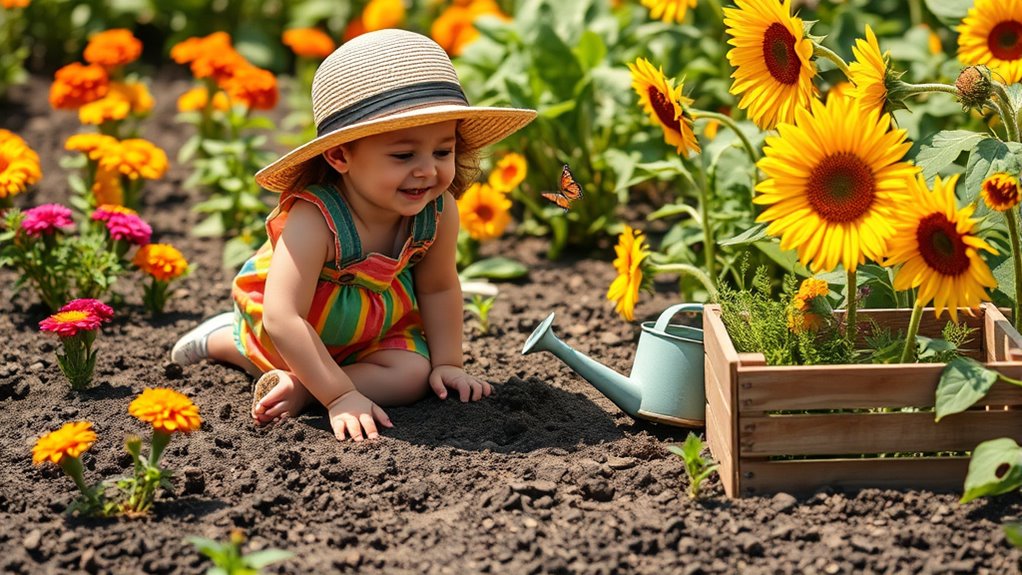
How can you guarantee your toddler’s garden is both safe and engaging? Start by selecting child-friendly plants that stimulate their senses and curiosity.
Consider growing sunflowers for their towering presence and vibrant colors, perfect for measuring growth together. Lamb’s ears and fountain grass offer soft textures for little hands to explore. Edible plants like strawberries and nasturtiums encourage tasting and snacking right from the garden. Additionally, ensuring your garden has a reliable water source will help keep these plants thriving. Incorporating crystal glassware for watering can add an elegant touch to your gardening routine. Including chia seeds in your gardening activities can introduce children to nutritious foods they can grow and enjoy. Furthermore, growing baked kale can provide a fun way for kids to learn about healthy eating while enjoying the garden’s bounty.
Herbs like mint and lemon balm introduce delightful scents and flavors. For seasonal interest, choose cosmos and dahlias to attract butterflies and bees.
Finally, opt for low-maintenance plants like radishes and basil to keep gardening manageable while fostering responsibility in your little one. Additionally, incorporating whole foods in your gardening activities can inspire a love for healthy eating. Happy planting!
Ensuring Safety and Supervision in the Garden
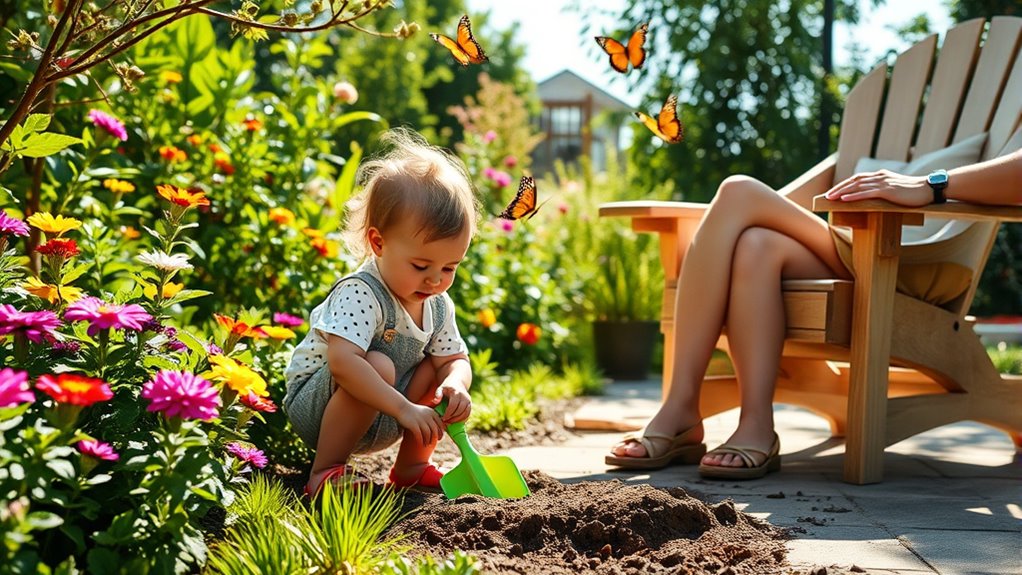
While tending to a garden can be a delightful experience for toddlers, guaranteeing their safety and supervision is essential.
Always provide constant supervision, especially for younger children who shouldn’t be left unattended. Make sure your garden area is fenced to keep them safe from streets and potential falls.
Use child-sized, durable tools, and teach them proper handling to prevent accidents. Store pesticides securely out of reach, and keep a first aid kit nearby for emergencies. Engaging in activities like educational play with toys can further enhance their learning experience while gardening.
Be mindful of physical hazards like hoses and guarantee they’ve access to shade and water. Additionally, ensure the garden is free from harmful chemicals to create a safe environment for the little ones.
Frequently Asked Questions
What Age Is Best to Start Gardening With Toddlers?
The best age to start gardening with toddlers is around two to three years old.
At this age, they’re curious and enthusiastic to explore. You can introduce them to simple tasks like watering plants or digging in soil.
They’ll love the sensory experiences and hands-on learning. Just keep activities short and engaging to hold their attention.
You’ll be amazed at how much they enjoy getting their hands dirty and connecting with nature!
How Can I Involve Siblings in Gardening Activities?
Involving siblings in gardening activities can transform a mundane chore into an exciting adventure. You can assign age-appropriate tasks, ensuring everyone contributes but also feels challenged.
Foster teamwork by setting shared goals and allocating specific roles, promoting ownership. Create fun projects, like building a bird feeder or designing themed gardens.
What Gardening Tools Are Suitable for Toddlers?
When choosing gardening tools for toddlers, look for mini garden tool sets that include small shovels and rakes.
Waterproof gardening gloves protect their hands while they explore. Size-appropriate watering cans make it easy for them to practice watering.
You can also consider lightweight wagons for transporting items and carrying bags to keep tools organized.
Opt for plastic tools for safety, ensuring they’re manageable and durable for little hands during gardening activities.
How Do I Handle Gardening Messes Indoors?
When it comes to indoor gardening adventures, a little mess is just a sign of creativity blooming!
To handle those spills, designate a gardening zone with easy-to-clean surfaces. Cover the area with newspapers or plastic sheets, and keep a handheld vacuum or broom handy for quick clean-ups.
Involve your little ones in the tidy-up process; it’s a fun way to teach responsibility while keeping your space neat and tidy!
What Should I Do if My Child Loses Interest in Gardening?
If your child loses interest in gardening, try mixing things up!
Introduce fun activities like scavenger hunts or themed projects, making it feel like an adventure. Let them choose which plants to grow, giving them a sense of ownership.
You could even create a garden journal together to spark curiosity. Incorporate cooking with garden produce, too—connecting gardening to meals can reignite their excitement.
Just keep it engaging, and they’ll likely rediscover their love for it!
Conclusion
By introducing your toddler to gardening, you’re not just cultivating plants; you’re nurturing a lifelong love for nature. Studies show that early exposure to gardening boosts kids’ creativity and cognitive skills, making it a fantastic learning experience. So grab those tiny tools and dig in together! You’ll create lasting memories while fostering curiosity about the natural world. Remember, the joy of gardening is in the journey, so enjoy every moment spent in the soil with your little one.
